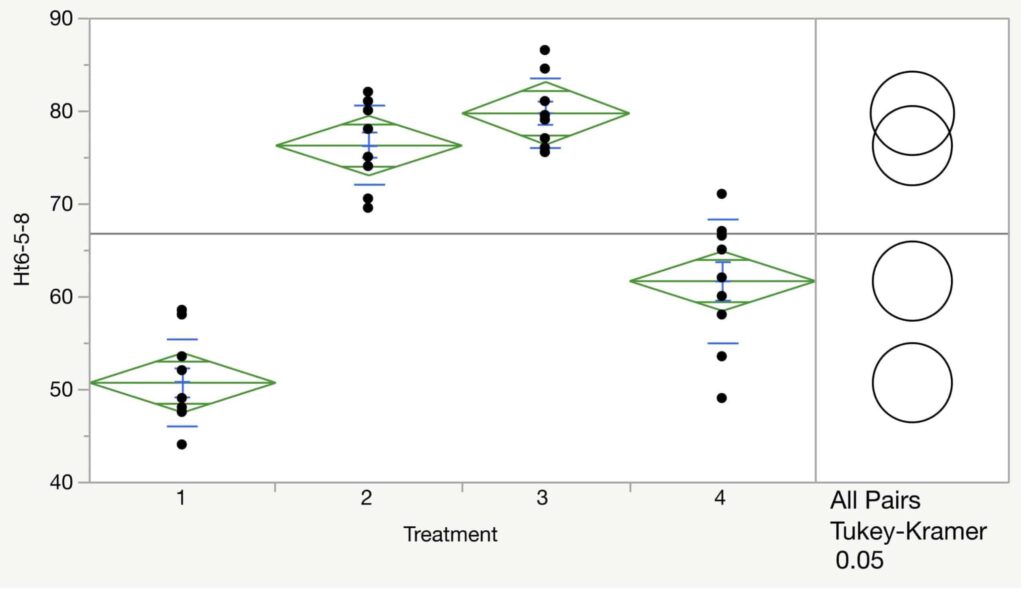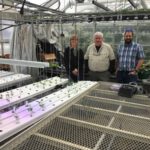Crown Pea Test
Effect of Oxygen Nano Bubbles in Hydroponic Irrigation Water on Growth and Development of the Crown Pea.
University of Wisconsin
Prepared by: Taylor North
Crown Pea Study

In a University study undergrad Taylor North, under the direction of Sonja Maki, PH.D and Assistant Professor in the Department of Plant and Earth Sciences at the University of Wisconsin-River Falls, achieved significantly better root development using the O2Grow system to add DO in a study growing crown peas.
“We had been noticing poor root development in two of our hydroponic settings,” says Maki. She said the DO measured pretty low at 5mg/L. “We tried adding air stones and it didn’t help much.”
North conducted an experiment using the crown pea because, as she explains, it’s a determinate plant that grows wide at the top and produces a lot of flowers. She conducted experiments using a control and the patented O2Grow technology and noticed a marked difference in the experimental plants.
“Overall it was wonderful, the electrolysis works phenomenal” says North, whose body of research on the crown pea and electrolysis was accepted and will be presented at a conference at Kennesaw State University in Georgia.


Abstract Presented to NCUR 2019 Conference at Kennesaw State University
GROWTH OF CROWN PEA IN A HYDROPONIC NFT SYSTEM WITH LED LIGHTING AND AN ENHANCED DISSOLVED OXYGEN ENVIRONMENT
Presented by: Taylor North, Sonja Maki, Department of Plant and Earth Science, UW-River Falls, 54022
The crown pea (Pisum sativum L.) is a determinate, fasciated line of pea which terminates growth on a widened stem and initiates numerous flowers that develop simultaneously. We were curious whether plant characteristics in this line could be altered in a nutrient film technique hydroponic system (NFT) with light emitting diode (LED) lighting and increased dissolved oxygen (DO) content in the irrigation water. Seeds of crown pea were sown in to phenolic foam blocks (Oasis) and germinated under mist in a greenhouse. At age 4 (four expanded leaves) plants in the foam blocks were transferred to one of four NFT environments: control, LED lighting (provided by Phillips Red and Blue LEDs), enhanced DO (provided by an O2Grow emitter), enhanced DO plus LEDs. Plant height and age were recorded weekly and root systems were weighed at the termination of the experiment. Overall, plant height and age was similar between treatments, however root growth was different among the four treatments. Roots of plants grown in the high DO and high DO plus LED environments were the greatest, followed by LED lighting. The roots in the control environment were the smallest. Root systems grown in the enhanced DO environments were significantly larger and lighter in color than those without enhanced DO. Apex width ranged from 5 mm to 20 mm, with the widest apex observed in the high DO environment plus LED light environment. Enhancing DO in irrigation water of NFT systems warrants further investigation for production of vigorous, healthy plant root systems of peas.
Controlled Study Data
Treatments 2 and 3 showed marked improvement in the root zone with added oxygen from O2Grow unit.
Hydroponic Treatments
- Treatment 1: Red/Blue LED lights, water + nutrients
- Treatment 2: Red/Blue LED lights, water + nutrients + nanobubbles of O2
- Treatment 3: water + nutrients + nanobubbles of O2
- Treatment 4: water + nutrients
- Oxygen supplied by an O2Grow unit

Mean (Age 6-5-8) vs. Treatment

Oneway Analysis of Age 6-5-8 By Treatment

Mean (Ht 6-5-8) vs. Treatment

Oneway Analysis of Age 6-5-8 By Treatment

Oxygen Effects on Hydroponic Roots of Crown Pea.
Oxygen Nano Bubbles





